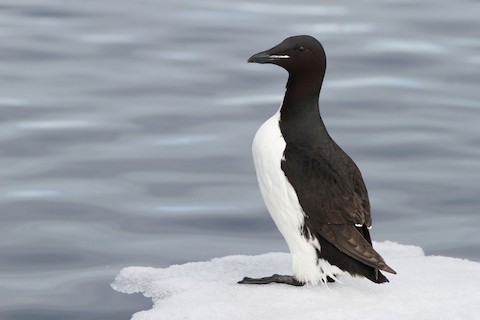Birdfinding.info ⇒ Locally abundant along the remote, rugged coasts where it breeds. Rare in Europe except in its principal breeding areas around Iceland, Finnmark, and Norway’s high arctic islands. There are accessible breeding colonies in western and south-coastal Alaska (St. Paul Island and Kenai Fjords) and Newfoundland (Cape St. Mary’s and Witless Bay). In the eastern U.S. it is seen regularly in winter at various seawatch points in the Northeast, including Cape Ann and Race Point, and occasionally in harbors and inlets along the New England coast.
Thick-billed Murre
Uria lomvia
Breeds on coasts and islands of the North Pacific, North Atlantic, and Arctic Oceans, and disperses to adjacent waters.
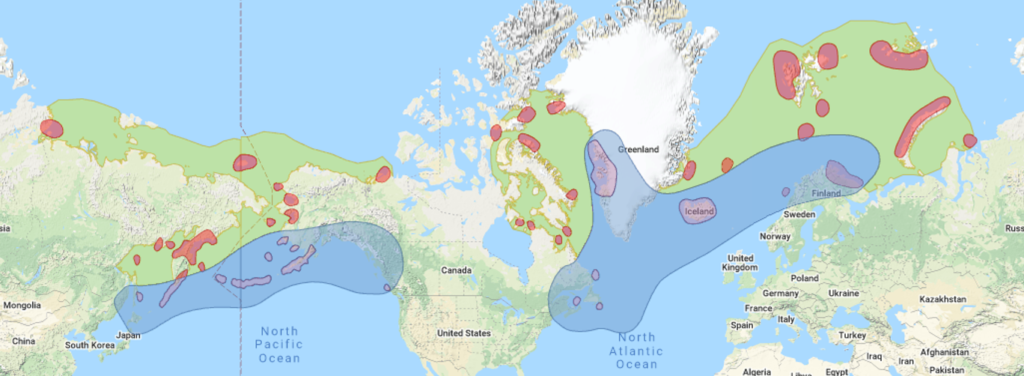
Approximate distribution of the Thick-billed Murre. © Xeno-Canto 2022
Breeding. Breeds from May to August in large colonies on sea cliffs and islets along the northern coasts of North America, Eurasia, and many arctic and subarctic islands.
Adults return to colonies in May and lay their eggs from June into early July. Most juveniles depart in August, with a few lingering into early September.
The breeding range is nearly circumpolar, but discontinuous, with somewhat distinct Pacific and Atlantic spheres.
On the Pacific side, breeding colonies are distributed around the Bering and Chukchi Seas and the Sea of Okhotsk: southwest to the southern Kuril Islands and southern Sakhalin; east to the Kenai Peninsula; and north to the New Siberian Islands, Wrangel Island, and Cape Lisburne. There are isolated colonies along the southeastern Beaufort Sea coast at Cape Parry and in southeastern Alaska on St. Lazaria Island in Sitka Sound.

Thick-billed Murre attending its cliffside nest on St. Paul Island in the Pribilofs. (June 22, 2017.) © Ken Oeser
On the Atlantic side, breeding colonies are even more widely dispersed: in eastern Canada from Ellesmere Island south to Coats Island (Keewatin), Hudson Strait, the Avalon Peninsula of Newfoundland, and Bird Rocks in the Gulf of St. Lawrence; western Greenland; Iceland; Jan Mayen; Svalbard; Bear Island; Finnmark; Franz Josef Land; Novaya Zemlya; and Severnaya Zemlya.
The global population was estimated at approximately 7.5 to 10 million pairs in the 1990s: 2.5 million in the Pacific and 5 to 7.5 million in the Atlantic. Concentrations were estimated at: Iceland, 22%; Bering and Chukchi, 22%; eastern Canada, 16%; Svalbard, 10%; Novaya Zemlya, 10%; Bear Island, 8%; Greenland, 6%; and the Sea of Okhotsk, 2%.
Nonbreeding. Winters at sea across upper latitudes of the North Pacific and North Atlantic, with substantial numbers remaining near the edge of the pack-ice in the zone of partly open waters and free-floating ice.
In the Pacific, regular wintering areas include the southern portions of the Bering Sea and Sea of Okhotsk, south to northeastern Honshu and the oceanic waters adjacent to its breeding grounds on the Kurils, the Kamchatka Peninsula, the Aleutians, the Alaska Peninsula, Kodiak Island, and the Kenai Peninsula. Winters more sparingly east across the Gulf of Alaska and south to British Columbia.
In the Atlantic, regular wintering areas extend from the Labrador Sea south to Massachusetts, and east across Icelandic and Norwegian offshore waters to the Barents Sea.
Scattered individuals appear sporadically south to the Sea of Japan, central California, North Carolina, and the North Sea.
More exceptional vagrants have been recorded from southern California, Florida, the Azores, and scattered locations in the interior of eastern North America, mostly along the St. Lawrence River, Lake Ontario, and Lake Erie.
Identification
A large, robust, black-and-white auk with a long, sharp-tipped bill. A prominent horizontal white line runs along the inner half of the upper mandible, like a pencil-thin moustache.
Extremely similar in all plumages to its sibling species, the Common Murre, which occurs together with it throughout most of their ranges, and the Razorbill, which overlaps widely in the North Atlantic. (For detailed comparisons, see below.)
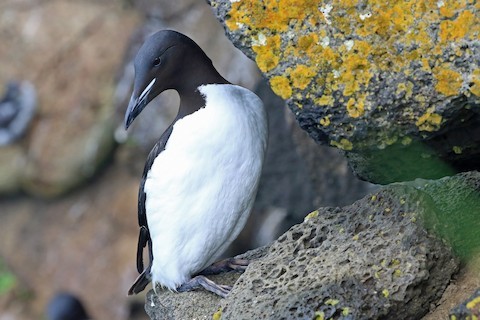
Thick-billed Murre in breeding plumage. (St. Paul Island, Alaska; June 20, 2016.) © Phillip Edwards

Thick-billed Murre, close-up showing white moustache stripe and subtle differences in plumage tones. (St. Paul Island, Alaska; June 20, 2012.) © Ryan O’Donnell
Breeding plumage is crisply defined: black upperparts contrast with all-white underparts. This pattern is nearly identical to the Common Murre’s, except that on Thick-billed the white of the underparts projects up to an angular point on the front of the neck.

Thick-billed Murre in breeding plumage, frontal view showing sharply angular boundary between black and white on the neck. (Lilliehöökbreen, Nordvest-Spitsbergen National Park, Svalbard; June 11, 2015.) © Christoph Moning
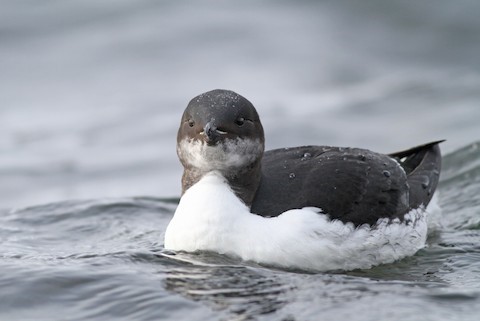
Thick-billed Murre in nonbreeding plumage, frontal view showing whitish throat framed by partial black collar. (Gloucester, Massachusetts; January 14, 2012.) © Jeremiah Trimble
Nonbreeding plumage is similar to breeding, except that the neck is mostly white and some of the borders between white and black become indistinct. The head remains mostly black, except for the throat, which is mostly whitish, framed by a partial (or sometimes complete) black collar.
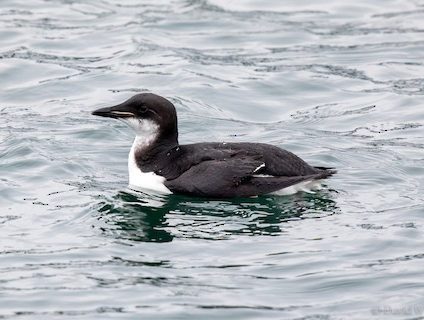
Thick-billed Murre in nonbreeding plumage, with an incomplete collar. (Gloucester, Massachusetts; February 16, 2020.) © David Young

Thick-billed Murre in first winter plumage—with features that suggest Common Murre, including a somewhat thin-looking, all-dark bill and some apparent streaking on the flanks, but note the head color. (Great Kills Park, Staten Island, New York; March 10, 2016.) © Maya Shikhman
In flight, the underside of the wing appears crisply bicolored: all-white lesser and median coverts contrast with darker flight feathers and greater coverts.
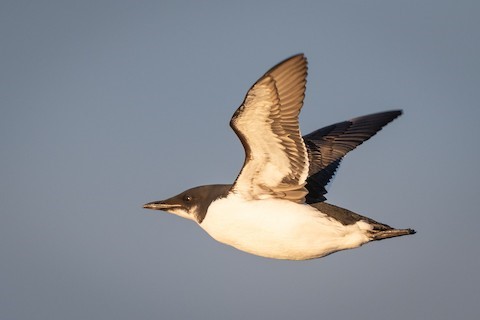
Thick-billed Murre in nonbreeding plumage, ventral view in flight showing underwing pattern. (Peggy’s Cove, Nova Scotia; January 10, 2019.) © Jason Dain
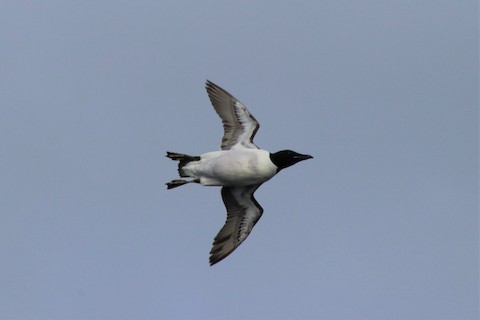
Thick-billed Murre in breeding plumage, ventral view in flight showing underwing pattern. (Pillar Rock, west of Kiska Island, Alaska; June 7, 2019.) © Alex Sundvall
Voice. Calls include deep growls and groans: And “laughter”:
Notes
Polytypic species consisting of four recognized subspecies. Known in the U.K. as Brünnich’s Guillemot.
See below for comparisons of the Thick-billed Murre with the Common Murre and Razorbill.
Cf. Common Murre. Common and Thick-billed Murres are both numerous, widespread species that occur together across large portions of the North Pacific and North Atlantic, breeding in many of the same colonies, often side-by-side. They can appear nearly identical, and can be especially confusing because some of the distinctions illustrated in field guides are variable and often ambiguous on live birds.
Bill Shape: According to its name, the Thick-billed Murre presumably has a thicker bill than the Common Murre. But to the contrary, when measured in the hand, their average bill depths are almost identical. The key difference is length: Common’s bill averages about 20-30% longer than Thick-billed’s, so it appears thinner.
Bill Stripe: Thick-billed’s most conspicuous feature is the white stripe along the inner half of the cutting edge of the upper mandible—which has the appearance of a pencil-thin moustache. However, it is not always present or clearly visible on all Thick-billeds, especially immatures. Reliance on this feature for identification is also complicated by the fact that Common’s bill often shows a similar whitish stripe, but usually much thinner and fainter—a source of confusion that is rarely illustrated in field guides.
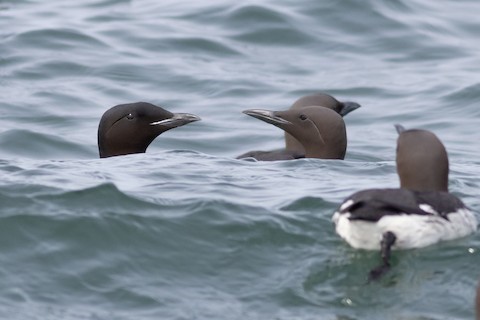
Thick-billed Murre (head only, at left) with Common Murres, enabling direct comparison of overall plumage coloration and bill and head shapes. (Kachemak Bay, Alaska; June 8, 2021.) © Tom Johnson

Thick-billed Murre in breeding plumage, showing characteristic V pattern on the neck and white “pencil-thin moustache” on the bill. (Longyearbyen, Svalbard; June 15, 2019.) © Egor Vlasov

Common Murre in breeding plumage—somewhat confusingly showing a V-like pattern on the neck and white “pencil-thin moustache” on the bill, resembling Thick-billed. (Gull Island, Witless Bay, Newfoundland; June 30, 2017.) © Pavel Parkhaev
Breeding Plumage: Common and Thick-billed Murres have essentially identical breeding plumages, with two small differences. Although both have blackish upperparts, Common is browner, Thick-billed is blacker—note that this distinction may require comparison in equivalent lighting to evaluate. The other difference is the boundary between black and white on the front of the neck, where Thick-billed typically shows an acute V. This distinction is also less consistent than field guide illustrations suggest, as Common Murre shows great variability in this feature, and it becomes especially ambiguous in some postures (when Common extends its neck, it looks more like Thick-billed, and when Thick-billed retracts its neck, it looks more like Common).
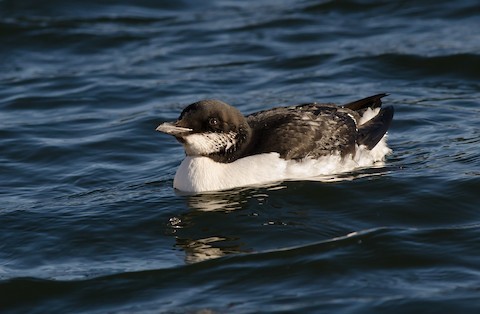
Thick-billed Murre in nonbreeding plumage—identifiable by its mostly black head and mostly white throat. (Clark’s Harbour, Nova Scotia; February 6, 2016.) © Alix d’Entremont
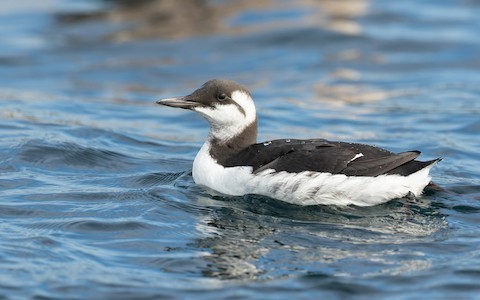
Common Murre in nonbreeding plumage—identifiable by its extensively white cheek divided by a thin black stripe. (Race Rocks, British Columbia; October 8, 2021.) © Blair Dudeck
Nonbreeding Plumage: Winter-plumaged murres are best identified by the extent of white on the head. Thick-billed’s head remains nearly all-black except for the throat, which turns whitish. In contrast, Common’s head turns mostly whitish from the throat up across the cheeks and behind the eye—the white area is divided by a bold black line that extends back from the eye and curves down toward the neck.
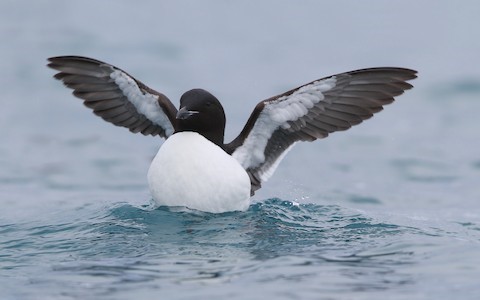
Thick-billed Murre in breeding plumage showing cleanly black-and-white underwing pattern in glare-free lighting. (Lilliehöökbreen, Nordvest-Spitsbergen National Park, Svalbard; June 11, 2015.) © Christoph Moning
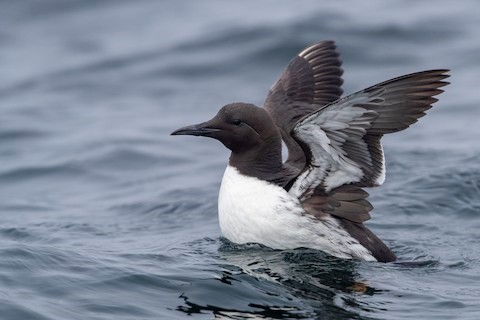
Common Murre in breeding plumage, showing black axillaries, black mixed into the underwing coverts, and dark streaks on the sides. (Iony Island, Habarovskij Kraj, Russia; June 12, 2016.) © Michael Stubblefield
Flank Pattern: In all plumages, Thick-billed has essentially all-white flanks, sometimes with a few subtle dark lines, whereas Common more typically shows broad, dusky streaks on its flanks. The streaks seem to be strongest in nonbreeding plumages and most noticeable when resting on the water.
Underwing Pattern: Thick-billed Murre’s underwings are evenly two-toned: white on the lesser and median coverts and dark on the flight feathers and greater coverts. Common’s underwings are similar but tend to show more black at the hinge (i.e., the axillaries), and usually a blackish strip that disrupts the white coverts.
Cf. Razorbill. The Thick-billed Murre is peculiarly intermediate in appearance between the Common Murre and the Razorbill. As all three occur together in much of the North Atlantic, and even share some of the same breeding colonies, identification at a distance often depends on discerning small details that differ among them.
Bill Shape: If seen clearly, the adult Razorbill’s bill is distinctive in both shape and pattern, but in some conditions it can be mistaken for Thick-billed. Both can appear thick and blunt, and both have a horizontal white stripe—but the Razorbill’s stripe is near the top whereas Thick-billed’s is in the middle. The subadult Razorbill’s bill has nearly the same profile as a Thick-billed Murre’s, so bill shape alone can be misleading without a clear view.
Nonbreeding Plumage: Thick-billed Murre and Razorbill have nearly identical breeding plumages, including the tone of the upperparts (both are blacker above than Common Murre). Nonbreeding plumages differ distinctively, however, as Thick-billed retains more black on the head, whereas Razorbill has a large white ear-patch (thus resembling Common Murre).
More Images of the Thick-billed Murre
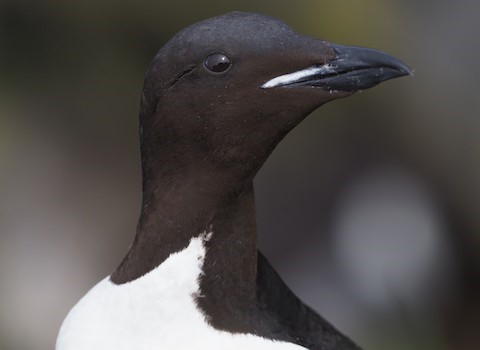
Thick-billed Murre in breeding plumage. (St. Paul Island, Alaska; July 18, 2019.) © Stephan Lorenz

Thick-billed Murre in breeding plumage. (St. Paul Island, Alaska; June 20, 2012.) © Ryan O’Donnell
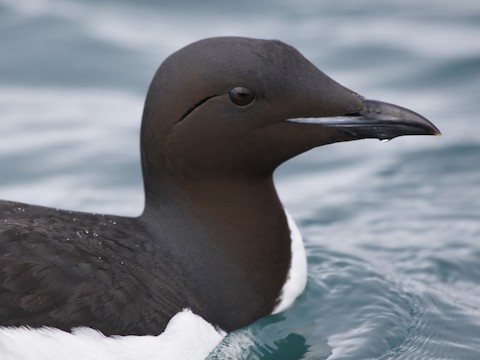
Thick-billed Murre in breeding plumage. (Alkefjellet, Svalbard; July 13, 2010.) © Christophe Gouraud
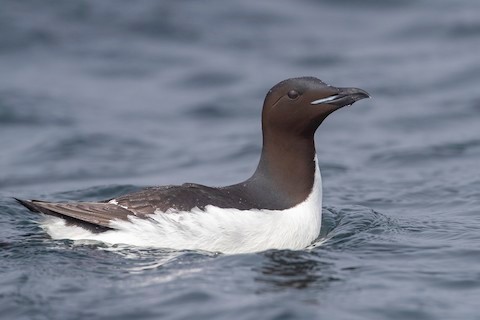
Thick-billed Murre in breeding plumage. (Iony Island, Sea of Okhotsk, Russia; June 12, 2016.) © Michael Stubblefield
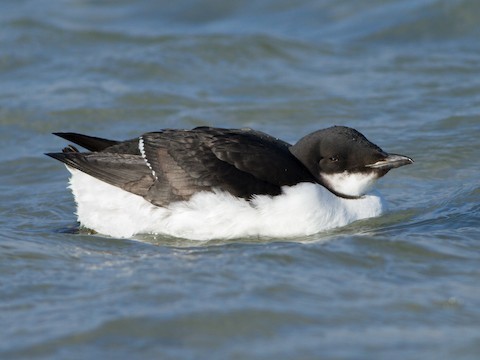
Thick-billed Murre in nonbreeding plumage. (Mason Inlet, Wilmington, North Carolina; January 17, 2015.) © Lucas Bobay
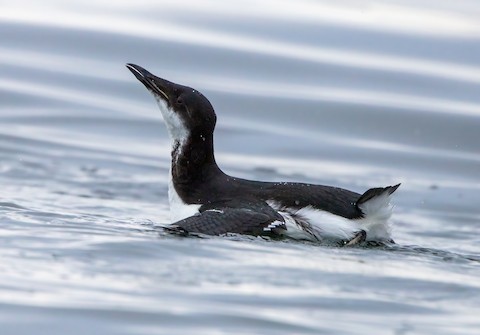
Thick-billed Murre in nonbreeding plumage. (Rockland, Maine; January 12, 2021.) © Robin Ohrt

Thick-billed Murre in nonbreeding plumage—note the apparently complete collar. (Rockland, Maine; January 12, 2021.) © Eddy Edwards
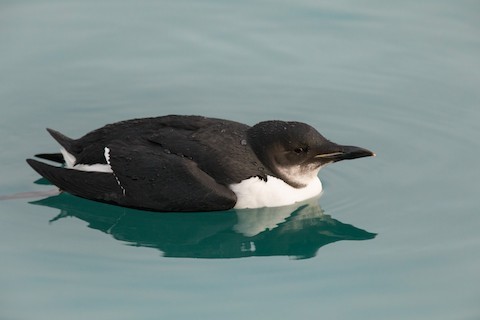
Thick-billed Murre in nonbreeding plumage. (Húsavík, Norðurland Eystra, Iceland; December 9, 2017.) © Gaukar Hjartarson
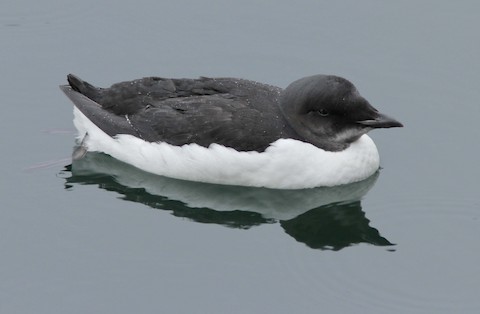
Thick-billed Murre in first winter plumage. (Kingston, Ontario; December 4, 2013.) © David Beadle

Thick-billed Murre in first winter plumage. (Provincetown, Massachusetts; February 18, 2017.) © Jeffrey Offermann
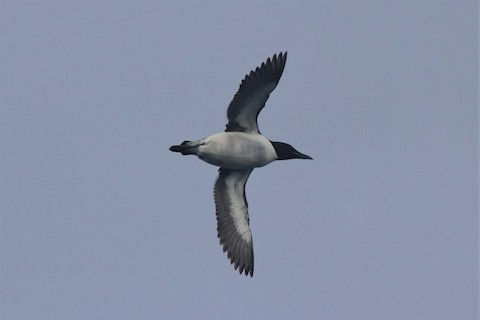
Thick-billed Murre in breeding plumage, ventral view in flight showing the underwing pattern. (Pillar Rock, west of Kiska Island, Alaska; June 7, 2019.) © Alex Sundvall
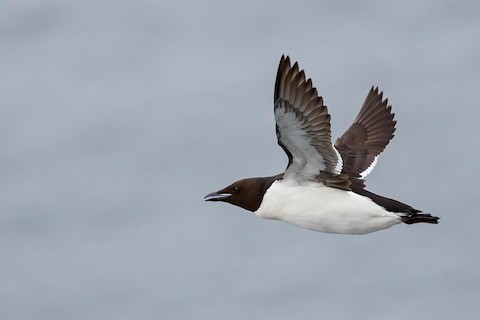
Thick-billed Murre in breeding plumage, ventral view in flight showing the underwing pattern. (Látrabjarg, Vestfirðir, Iceland; June 5, 2021.) © Yann Kolbeinsson
References
Alderfer, J., and J.L. Dunn. 2014. National Geographic Complete Birds of North America (Second Edition). National Geographic Society, Washington, D.C.
BirdLife International. 2018. Uria lomvia. The IUCN Red List of Threatened Species 2018: e.T22694847A132066134. https://dx.doi.org/10.2305/IUCN.UK.2018-2.RLTS.T22694847A132066134.en. (Accessed January 26, 2022.)
Brazil, M. 2009. Birds of East Asia. Princeton University Press.
eBird. 2022. eBird: An online database of bird distribution and abundance. Cornell Lab of Ornithology, Ithaca, N.Y. http://www.ebird.org. (Accessed January 26, 2022.)
Gaston, A.J., and I.L. Jones. 1998. The Auks: Alcidae. Oxford University Press.
Harrison, P. 1983. Seabirds: An Identification Guide. Houghton Mifflin, Boston.
Howell, S.N.G., and K. Zufelt. 2019. Oceanic Birds of the World. Princeton University Press.
Sibley, D.A. 2014. The Sibley Guide to Birds (Second Edition). Alfred A. Knopf. New York.
Svensson, L., K. Mullarney, and D. Zetterström. 2009. Birds of Europe (Second Edition). Princeton University Press.
Xeno-Canto. 2022. Thick-billed Murre – Uria lomvia. https://xeno-canto.org/species/Uria-lomvia. (Accessed January 26, 2022.)
